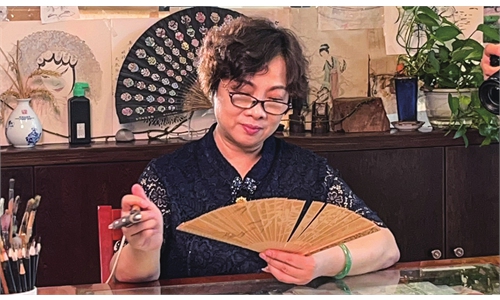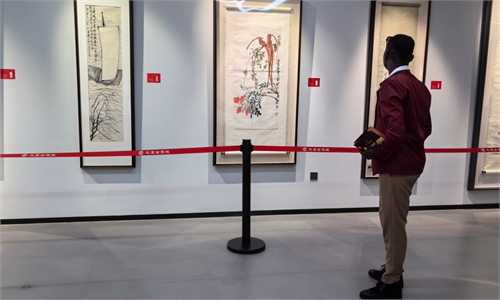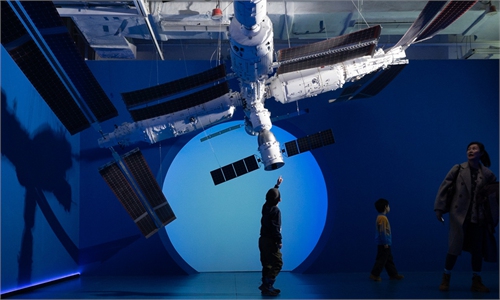ARTS / CULTURE & LEISURE
One year on, Xi Jinping Thought on Culture leads path to national rejuvenation
Reviving culture, spearheading innovation
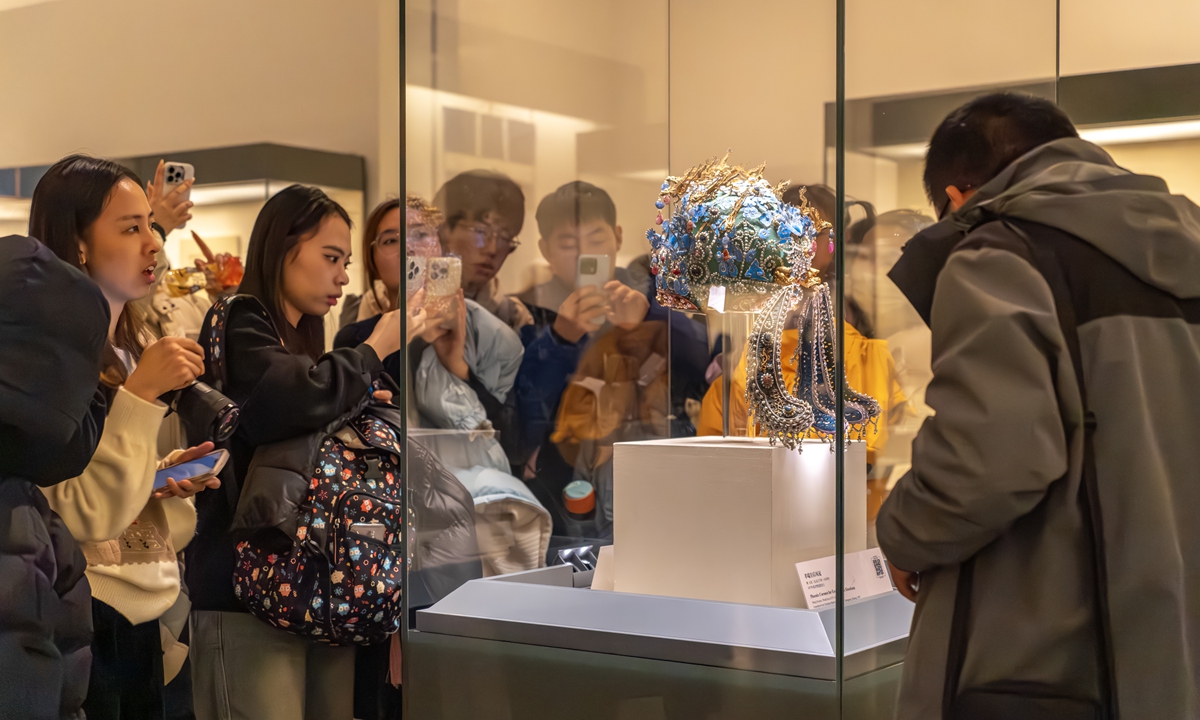
Visitors observe a Ming Dynasty (1368-1644) phoenix crown at the National Museum of China in Beijing. Photo: VCG
Editor's Note:
Xi Jinping Thought on Culture, formally put forward in October 2023, encompasses several key aspects, including strengthening the Party's leadership over public communication and culture and promoting the creative transformation and innovative development of China's fine traditional culture.
Theorists state that the establishment of the thought shows that the Party's historical and cultural confidence have reached new heights.
"If there were no 5,000 years of Chinese civilization, where would the 'Chinese characteristics' come from? And if it were not for these Chinese characteristics, how could we have today's successful path of socialism with Chinese characteristics?" Xi once said.
Since the introduction of Xi Jinping Thought on Culture, "culture" has become a buzzword throughout China over the past year. In this issue, Global Times reporters Xu Liuliu, Chen Xi, Li Yuche and Ji Yuqiao explore various lively practices throughout the country to study the Thought and turn it into guidance for work and life.
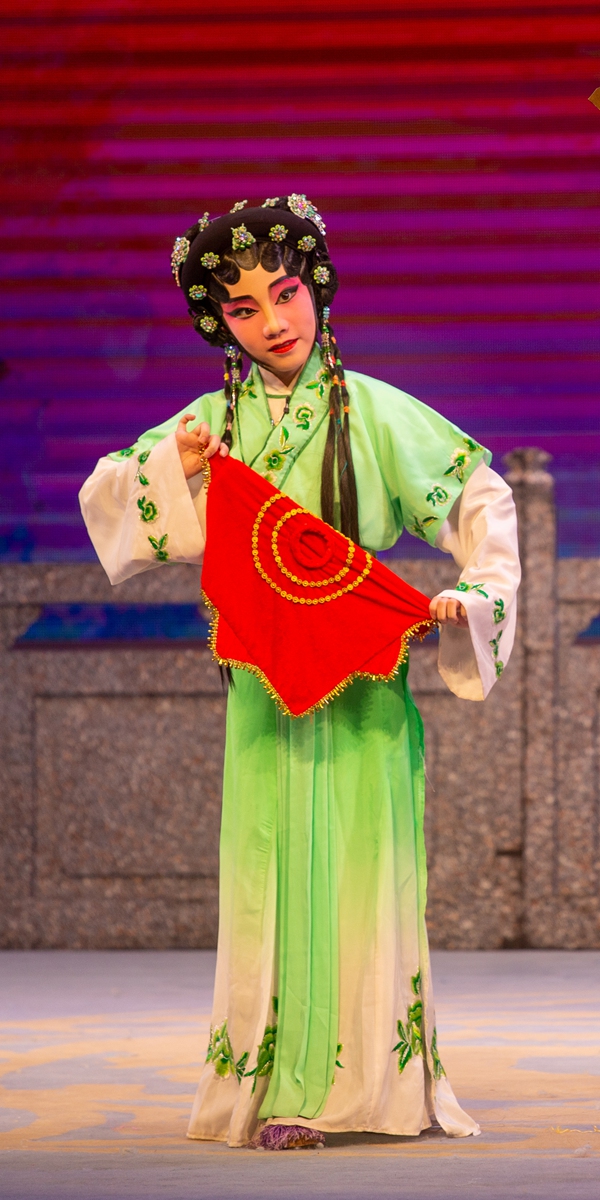
A young Cantonese opera actress performs on the stage. Photo: VCG
For 17-year-old Cantonese opera singer Li Man-chit, the costume he was wearing was a little too small. However, it was indeed a treasure that Li cherishes very much.Seven years ago, dressed in traditional clothing, he performed a selection from the Cantonese opera classic The Purple Hairpin for President Xi Jinping during his inspection of the Hong Kong Special Administrative Region (SAR) in 2017.
Xi watched some selections of Cantonese opera performed by children including Li. Xi said that traditional cultural forms including Cantonese opera had new development opportunities after Hong Kong's return to the motherland.
The president said that he hoped the HKSAR can carry forward the traditional culture, play its role as a platform facilitating the Chinese and Western cultural exchanges, and promote cultural exchange and cooperation with the mainland.
Cultivating successors
Even after seven years, Li still remembers Xi's encouragement.
In his Thought, Xi set clear tasks for public communication and culture, including cultivating generations of young people with sound values and ethics, developing Chinese culture, and better presenting China to the world.
Li has played various characters over the years, including Xu Xian, Jia Baoyu, Zhou Yu and Su Qin. "Cantonese opera has helped me understand these characters better. The beauty of traditional Chinese culture conveyed in the story also deeply attracted me," he noted.
"I want to visit the Forbidden City in Beijing again," the young man told the Global Times. "And the West Lake in Hangzhou as well. I want to see the Broken Bridge where Xu Xian and White Snake met."
According to the Legend of the White Snake, White Snake transformed into a beautiful lady and came across Xu Xian on the Broken Bridge in the West Lake in order to requite Xu's favor of saving its life in his previous life.
"In the process of learning Cantonese opera, I can always deeply feel the breadth and depth of traditional Chinese culture from the characters I play and the storylines I interpret," Li said.
Cantonese Opera was inscribed onto the UNESCO Representative List of the Intangible Cultural Heritage of Humanity in 2009. It is widely cherished in Cantonese-speaking parts of China, including Guangdong, Hong Kong, and Macao, as a jewel in the crown of Cantonese culture.
The Xiqu (Chinese opera) Center in the West Kowloon Cultural District is the first landmark venue designed for Chinese operas in Hong Kong. Its mission is to preserve, promote and develop the art of traditional Chinese theater, to nurture local forms of Cantonese Opera and to promote other forms of Chinese opera. It is a major source of inspiration for the Cantonese Opera community in Hong Kong.
"Traditional opera has taken on new life," Naomi Chung, head of Chinese opera at the West Kowloon Cultural District, told the Global Times. Over the past years, she has participated in almost every activity organized by the Xiqu Center to popularize Cantonese Opera.
"Extending the vitality of Cantonese Opera, passing on this precious culture and art form from generation to generation, and cultivating successors is a particularly important task," said Chung.
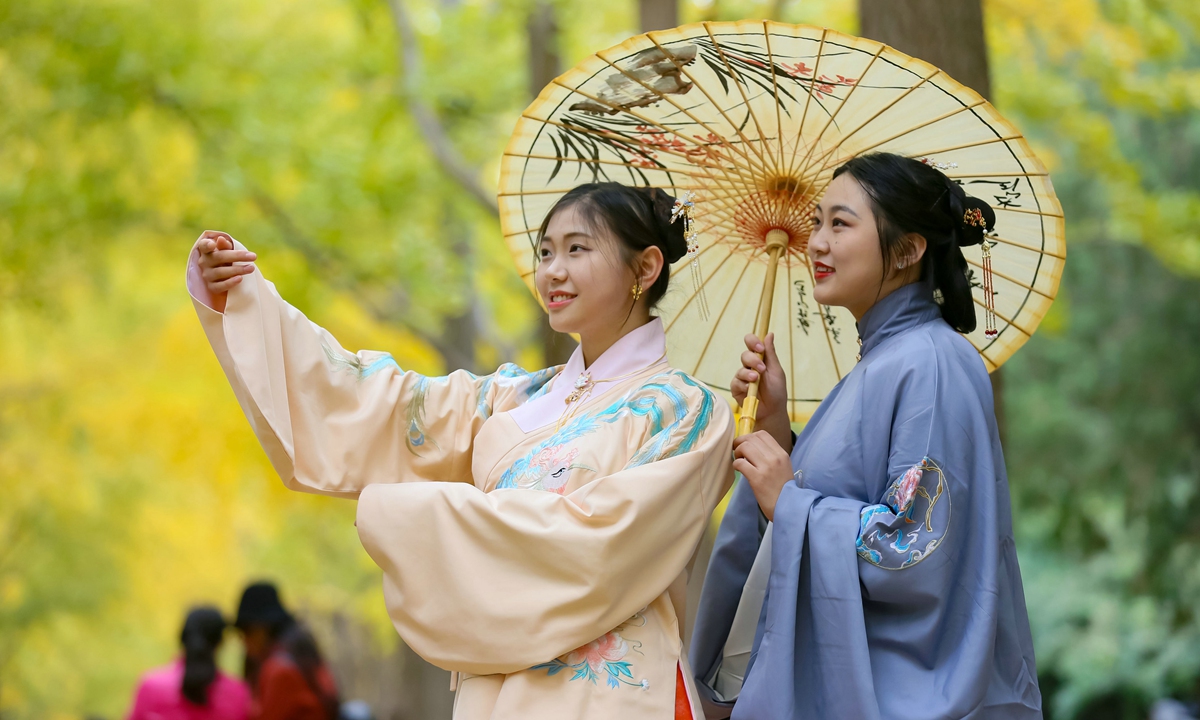
Young women in Hanfu, the traditional clothing of China's Han ethnic group. Photo: VCG
Appeal of Chinese cultureXi Jinping Thought on Culture bears immense importance in the pursuit of a stronger China and the realization of national rejuvenation. Rooted in China's 5,000 years of civilization, the Thought places a profound emphasis on the preservation and development of fine cultural traditions.
President Xi has called on the Chinese people to cherish, honor and deepen their knowledge of the Chinese civilization and strengthen cultural confidence.
Relics, as carriers of the national spirit, can offer insight into appreciation of Chinese culture.
The numbers are telling. In 2023, over 1.29 billion visits were made to museums across the country to see more than 40,000 exhibitions, a new high. In Beijing, long lines can be seen almost every day in front of the National Museum of China (NMC), which has a large collection of the country's top historical relics.
Gao Yinwen, a docent from the museum, told the Global Times that the NMC has always been highly popular among both young and old visitors from China and from abroad.
"The biggest tourism rush usually happens during the summer holiday. I think the volume per day can reach over 20,000 visitors," she said.
Since the summer holiday is a peak time as many students are participating in study tours, the museum has set up special tour guides for them.
Gao said one of the most popular exhibitions in the museum is the permanent exhibition Ancient China.
The Ancient China exhibition was packed with tourists. Among the crowd, a group of Thai visitors were observing the Chinese ancient cultural relics as a guide patiently and passionately introduced the history of each artifact in Thai.
Somchai Jiu, a 60-year-old guide from Thailand, told the Global Times this was his fourth time visiting the National Museum of China. As an overseas Chinese living in Thailand, Jiu said he was a die-hard fan of Chinese history and has always been amazed by the artifacts unearthed from the mysterious Sanxingdui Ruins.
The well-known Erlitou site, where more than 10,000 priceless cultural relics have been unearthed, is the favorite of Ge Haiyan, a 46-year-old female visitor from Luoyang, Central China's Henan Province.
Ge told the Global Times that she took her son and her father to the NMC hoping to see more priceless cultural relics unearthed from Erlitou since she and her family are from Luoyang and live near the site.
As a Luoyang native, Ge said she has noticed that more people are flooding into her hometown to visit the Luoyang Museum, which has now implemented a reservation system due to a need to control the number of visitors it receives daily.
The project to trace the origins of Chinese civilization, which proves that China's history includes more than 5,000 years of civilization, has not only helped Chinese people to better understand the successive development of the civilization but also summarized the unique characteristics of Chinese civilization and its contributions to humanity through a series of archaeological discoveries and academic research, Wang Wei, chief expert of the project and also researcher with the Chinese Academy of Social Sciences, told the Global Times.
"The firm archaeological evidence regarding the origins of Chinese civilization is important for enhancing the cultural confidence of Chinese people, which is visually reflected by the sharp rise in the number of visitors to museums nationwide," said Wang.
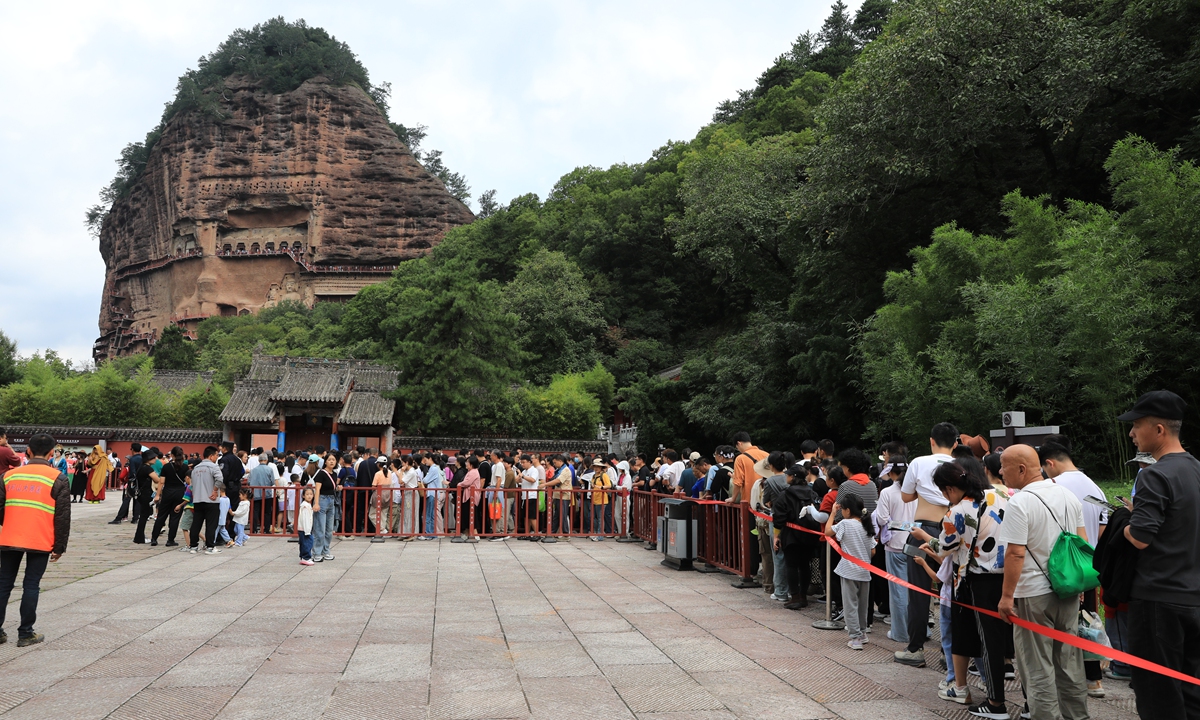
Visitors wait in line to explore the Maijishan Grottoes in Tianshui, Northwest China's Gansu Province. Photo: VCG
Root of confidenceXie Maosong, a senior researcher at the China Institute for Innovation & Development Strategy and the director of the Research Center of Chinese Civilization and Chinese Path, told the Global Times that "cultural confidence" is not just a term that stands on its own. Museums provide young people with a public cultural space to acquire knowledge and find themselves. Here, they gain cultural experiences that transcend time and space, as well as emotional resonance. A strong sense of cultural belonging is becoming one of the most prominent tags among today's youth.
The People's Republic of China just celebrated its 75th founding anniversary on October 1, 2024. The country's achievements have a historical and cultural logic behind them. The path of socialism with Chinese characteristics that the Chinese people have embarked on is deeply rooted in the more than 5,000-year-old civilization of China, which is where people's national confidence comes from.
As an experienced guide at China's UNESCO World Heritage site the Maijishan Grottoes, Li Zekun will never forget Xi's visit to the site in September.
The site in Tianshui, Gansu Province, has 1,600 years of history. Li was one of the staff members at the site who has planned the trip route for President Xi.
In Tianshui, Xi's visit included a trip to the Maijishan Grottoes to learn about the protection and preservation of local cultural heritage.
Li told the Global Times that the No.43 and No.44 caves at the grottoes were highlights of the trip. Both caves were created during the Western Wei Dynasty (535-556). Dubbed as the "Mona Lisa of the East," the buddha statue in Cave No.44 carries a distinctive gentle and gracious smile, and embodies the refined art of Chinese sculpture.
Having committed herself to her job for nine years ago, Li has gained precious first-hand experience with China's diverse culture. She told the Global Times that her mindset has gradually changed from an immature graduate to a professional guide who "feels the responsibility to promote Chinese heritage among the public."
"As a younger generation cultural worker, I have deep confidence in my cultural roots. Although I know my abilities are limited, I will still try my best," said Li.
Confidence in one's own culture, seen as a broader, deeper and more fundamental expression of self-confidence, stands as the most vital, profound and enduring wellspring of strength for the progress of a country and its people.
In Xi's words: "Without full confidence in our culture, without a rich and prosperous culture, the Chinese nation will not be able to rejuvenate itself."



